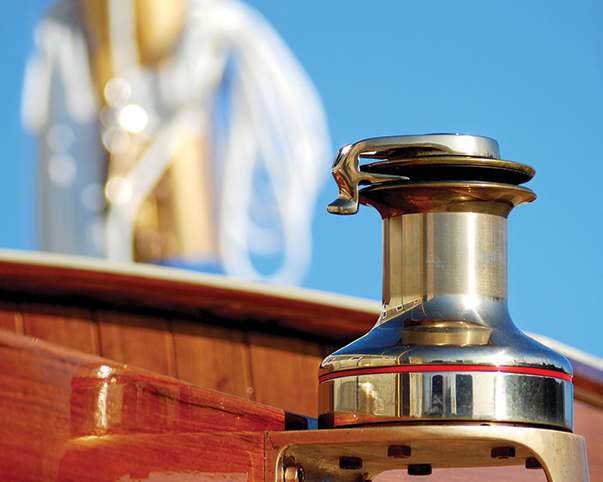(published April 2017)
If you have never pulled apart your sheet and halyard winches, you might be surprised at what simple and elegant machines they are on the inside. Winches are built around the drum on the outside that carries the sheets or lines. They come in a range of designs for various purposes, whether it be basic cruising or high end grand prix racing.
For blue water sailors, most skippers will opt for modern stainless steel, chrome bronze or aluminum drums that have a non-slip pattern molded into the drum’s surface. Andersen winches, built in Denmark, have stainless steel drums that have a ribbed pattern that provides just enough friction to keep the sheet or line from slipping on the smooth metal surface.
Harken produces stainless drums for their hydraulic line of winches but offers mainly aluminum, chrome, bronze and carbon fiber drums for various purposes. Similarly, Lewmar offers aluminum and chrome finished drums for most of their winches, with only a couple of stainless steel models in their catalog. Like the Andersen winches, Harken uses a ribbed pattern on the drum to reduce slippage; Lewmar uses a non-skid pattern that grips the line without cutting into the fibers.
Aluminum drums are also very common on cruising boats. The drums are lighter than stainless steel or chrome-bronze and the anodized= surfaces stand up well to the marine environment and rugged use. You will find aluminum drums on racer-cruisers and racing boats. Harken uses a ribbed pattern in their aluminum drums, while Lewmar relies on a non-skid pattern to resist line slippage.
For traditionalists, bronze drums evoke days of yore and add a handsome touch to a woody and varnished styling on classic yachts and retro modern designs. Bronze requires a bit of maintenance since they need to be polished from time to time. And, they can show wear after long, hard use.
Antal is the fourth largest winch manufacturer but they do not have a significant presence in the U.S. And, Pontos has recently introduced their four-speed winches t the U.S. but, again, they do not yet have wide distribution.
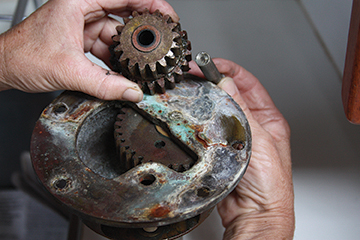 INSIDE
INSIDE
Winches use leverage and gears to increase the power of a human’s arm to grind in sheets and lines and bearings to reduce friction as much as possible. Leverage comes from the length of the winch handle. Most manual winches these days are two-speed machines that offer fast trim when the handle is turned in one direction (often a 1:1 ratio), and a low gear for final trim when the handle is turned in the reverse direction (often a 5:1 ratio).
Most manual winches turn in only one direction, clockwise. The drum sits on roller bearings that keep it rolling easily and effortlessly. Keeping the bearings clean allows the rollers to operate efficiently. Pawls with springs keep the drum from reversing direction under load.
The gears that turn the winch are normally bronze or a mixture of bronze and stainless steel. It is important to keep these lightly greased to reduce wear and friction. The two-speed functionality depends upon smooth gear changes so too much grease or not enough will prove to be a problem.
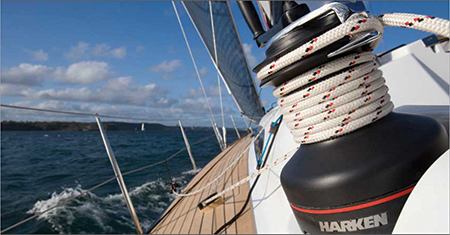 SELF TAILING
SELF TAILING
One of the great technical advancements that has made sailing easier, safer and more accessible to a wide range of people is the self-tailing function of modern winches. Invented by Maurice DeClercq and patented in 1974, the self-tailing mechanism uses a spring loaded line capture cap on top of the winch drum and a line feeder to grab the line, hold it and release it as the winch is turned. The line capture cap uses slightly ribbed jaws to grip the sheet or line and a spring mechanism to clamp down on it.
The first company to really make self-tailing winches reliable and commercially viable was Barient in 1976. Unfortunately, Barient has gone the way of the Dodo but the concept of self-tailing and the mechanisms that make it happen remain today. All winch manufacturers offer self-tailing winches as their standard for cruising and racing boats.
One of the most recent developments in self tailing winches is cockpit winches that are able to sheet in and sheet out—turn both ways—without removing the line or sheet from the self-tailing jaws. The Lewmar Revo and Harken Rewind Radial, both with electric motors, allow you to sheet in and sheet out with the push of a button.
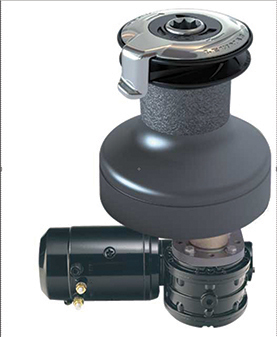 ELECTRIC WINCHES
ELECTRIC WINCHES
Electric winches used to be found only on yachts over 60 feet or so and were considered too expensive and too sissy for many traditional sailors. That’s all changed. Electric winches are now found on sailboats from 35 feet and up.
The most common use for an electric winch is for a single utility winch on the cabin top where halyards and control lines run back from the mast to the cockpit. These can include the main and jib halyards, the roller furling control lines for a roller furling genoa and an in-mast or in-boom roller furling mainsail. Plus you will have control lines for the boom vang and the mainsheet traveler.
With the aid of blocks or line organizers, you can also use this single utility winch to hoist an outboard from the dinghy to the stern rail, hoist a dinghy onto the foredeck and hoist a person up the mast for rig inspections and repairs. A single electric winch can be a real boon for sailors who are small or those who are getting to the ends of their sailing careers.
It is becoming more common, also, to find electric sheet winches on modern cruising boats. This has happened for two reasons: boats are getting bigger and the folks who are doing most of the sailing and cruising are getting older. A little electricity can add years to a sailor’s sailing life.
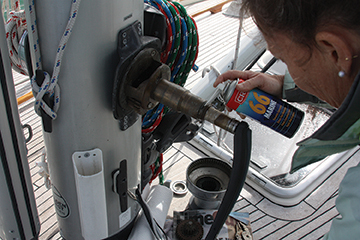 For most electric winches, the motor mounts under the deck or cabin top beneath the winch and the cables, which are heavy gauge, run to a fuse box. Under load, an electric winch can draw a lot of amps so you have to be careful that your battery bank is topped up. If you overload an electric winch, the fuse might pop to shut the winch down. Or, in some models, if the motor overheats, the winch will shut itself down. It is a good idea to have the fuse close to the cockpit. The switches that operate the winch need to be located where they can be used easily.
For most electric winches, the motor mounts under the deck or cabin top beneath the winch and the cables, which are heavy gauge, run to a fuse box. Under load, an electric winch can draw a lot of amps so you have to be careful that your battery bank is topped up. If you overload an electric winch, the fuse might pop to shut the winch down. Or, in some models, if the motor overheats, the winch will shut itself down. It is a good idea to have the fuse close to the cockpit. The switches that operate the winch need to be located where they can be used easily.
In a normal installation, the electric motor will be under the coaming or cabin top and will take up some interior space. There are two models that are easy to install and do not require a large motor and gear box. The Harken Unipower Radial has the motor mounted vertically beneath the drum which makes it simple to install. Andersen offers their Compact Motor above deck mounting system that has the motor encased in a cylinder that mounts on a coaming or cabin top and has the winch mounted on top of it. Andersen also offers this motor for an under deck or coaming mount.
RETROFITTING WITH ELECTRIC
Many sailors have boats with manual winches and are considering whether they should buy new electric winches for the cabin top and cockpit. All three of the major winch manufacturers in the U.S. market offer kits for converting their larger winches from manual to electric.
The kits come with all the parts you need, templates and instructions. Any handy boat owner with tools and a bit of practical knowledge of how an electrical device should be installed and wired, can undertake a winch conversion. Or, any boatyard can do it for you.
One of the key elements when considering retrofitting your winches with electric motors will be determining how that will affect your boat’s energy profile. Will you need to add another battery to your house bank? Or, should you set up a separate battery bank for the electric winches as you would for a bow thruster? And, will you need to upgrade your alternator to meet the new demand on the battery bank?
But, adding electric power to your winches will increase your fun out sailing and will help to extend your sailing career.















